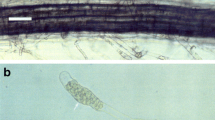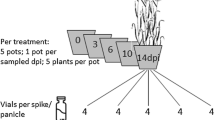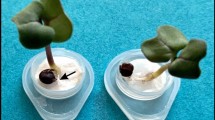Abstract
Germination of surface-disinfected resting spores ofPlasmodiophora brassicae and its infection of turnip hairy root hairs were studied. Surface-disinfected resting spores showed higher germination than non-disinfected resting spores. Root hair infection was most frequent in the section of root formed 1 d before inoculation. Root hair infection began 4 d after inoculation, increased up to 6 d, and continued to increase more slowly until 10 to 12 d after inoculation. Growth ofP. brassicae in the root hair of hairy roots was observed serially. Most primary plasmodia differentiated to mature zoosporangia 8–10 d after inoculation. The secondary zoospores were initially released 6 d after inoculation.
Similar content being viewed by others
Literature cited
Aist, J. R. and Williams, P. H. 1971. The cytology and kinetics of cabbage root hair penetration byPlasmodiophora brassicae. Can. J. Bot.49: 2023–2034.
Asano, T., Kageyama, K. and Hyakumachi, M. 1999. Surface disinfestation of resting spores ofPlasmodiophora brassicae used to infect hairy roots ofBrassica spp. Phytopathology89: 314–319.
Ayers, G. W. 1944. Studies on the life history of the clubroot organism,Plasmodiophora brassicae. Can. J. Res. Sect. C.22: 143–149
Becard, G. and Fortin, J. A. 1988. Early events of vesiculararbuscular mycorrhiza formation on Ri T-DNA transformed roots. New Phytol.108: 211–218.
Bochow, H. 1965. The effect of root diffusates of host and non-host plants on the resting, spore germination ofPlasmodiophora brassicae Wor. In: Microbes Relationships (Proceeding of a symposium on relationships between soil microorganisms and plant roots, 1963). (ed. by Macura, J. and Vancura, V.), pp 296–299. House of the Czechoslovak Academy of Prague.
Diaz, C. L., Spaink, H. P., Wijffelman, C. A. and Kijne, J. W. 1995. Genomic requirements ofRhizobium for nodulation of clover hairy roots transformed with the pea lectin gene. Mol. Plant Microbe Interact.8: 348–356.
Graverand, R., Dale, P. and Mithen, R. 1992. Gall development in hairy root cultures infected withPlasmodiophora brassicae. Mycol. Res.96: 225–228.
He, Y.-K. 1991. Infection of Ri T-DNA-transformation roots byPlasmodiophora brassicae inBrassica crops. Scince in China (Series B)34: 1444–1451.
Ingram, D. S. 1969. Growth ofPlasmodiophora brassicae in host callus. J. Gen. Microbiol.55: 9–18.
Ingram, D. S. and Tommerup, I. C. 1972. The life history ofPlasmodiophora brassicae Woron. Proc. Royal Soc. London Ser. B.180: 103–112.
Kageyama, K., Kamimura, Y. and Hyakumachi, M. 1995. A simple inoculation method with a single resting spore ofPlasmodiophora brassicae, Ann. Phytopathol. Soc. Jap.61: 415–418.
Katsura, K., Tamura, M. and Yamaguchi, N. 1970. Some observations on the infection ofPlasmodiophora brassicae Woronin in root hair of Cruciferae plants. Proc. Kansai Pl. Prot.12: 23–29.
Macfarlane, I. 1970. Germination of resting spores ofPlasmodiophora brassicae. Trans. Br. Mycol. Soc.55: 97–112.
Mugnier, J. 1987. Infection byPolymyxa beate andPlasmodiophora brassicae of roots containing root-inducing transferred DNA ofAgrobacterium rhizogenes. Phytopathology77: 539–542.
Murashige, T. and Skoog, F. 1962. A revised medium for rapid spore density ofPlasmodiophora brassicae Wor. to the root hair infection and club formation in Chinese cabbage (Studies on the clubroot of Cruciferous plant II). Ann. Phytopathol. Soc. Jap.44: 432–439.
Ogawa, T. 1998. Factors affecting the germination of resting spores ofPlasmodiophora brassicae Woronin. Master thesis Gifu University, Gifu, Japan.
Plenchette, C., Declerck, S., Diop, T. A. and Strullu, D. G. 1996. Infectivity of monoaxenic subcultures of the arbuscular mycorrhizal fungusGlomus versiforme associated with Ri-T-DNA-transformed carrot root. Appl. Microbiol. Biotechnol.46: 545–548.
Samuel, G. and Garrett, S. D. 1945. The infected root hair count for estimating the activity ofPlasmodiophora brassicae in the soil. Ann. App. Biol.32: 96–101.
Suzuki, K., Matsumiya, E., Ueno, Y. and Mizutani, Y. 1992. Some properties of germination-stimulating factor from plant for resting spores ofPlasmodiophora brassicae. Ann. Phytopathol. Soc. Jap.58: 699–705.
Takahashi, K. 1994. Biological agents affecting the viability of resting spores ofPlasmodiophora brassicae Wor. in soil without host roots. Ann. Phytopathol. Soc. Jap.60: 667–674.
Tommerup, I. C. and Ingram, D. S. 1971. The life-cycle ofPlasmodiophora brassicae Woron. inBrassica tissue cultures and in intact roots. New Phytol.70: 327–332.
Author information
Authors and Affiliations
About this article
Cite this article
Asano, T., Kageyama, K. & Hyakumachi, M. Germination of surface-disinfected resting spores ofPlasmodiophora brassicae and their root hair infection in turnip hairy roots. Mycoscience 41, 49–54 (2000). https://doi.org/10.1007/BF02464385
Accepted:
Issue Date:
DOI: https://doi.org/10.1007/BF02464385




